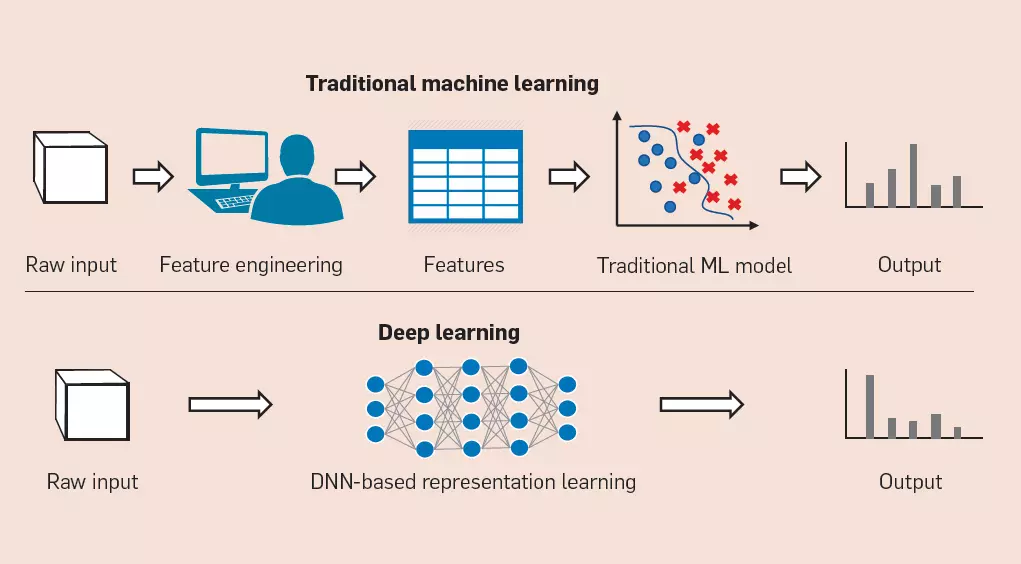Comments
- No comments found

Before implementing deep learning for business, it is vital that business leaders understand the capabilities and features of this path-breaking technology.

Deep learning is a type of machine learning in AI that gathers huge datasets to make machines act like humans. Due to the use of neural networks, deep learning produces optimized results. You must have observed how Facebook automatically finds your friend in an image and suggests you tag her. Here, Facebook uses deep learning to recognize your friend. We were amazed to read what Gartner had to predict for about deep learning. It said, “Deep learning will soon provide best-in-class performance for demand, fraud and failure predictions.” Such a prediction encourages business leaders to implement deep learning for business and drive their business to greater success. While most business leaders are aware of the term, deep learning, they have very little to no understanding of the technology. Before leveraging deep learning for business, leaders should take a look at what deep learning offers and what the future of deep learning will look like.
For any business, the ultimate goal is to make profits. Organizations can make profits only if customers buy their products or service. Hence, every company aims at keeping their customers happy and fulfilling their demands. In any business, leaders must ask questions like:
What are the challenges faced with the current model?
How can deep learning help overcome the challenges?
How will the technology help to keep customers happy and attract new customers?
What are the areas in their business where they can implement deep learning to make higher gains?
Shared below are few deep learning applications that every business leader must leverage:
Image recognition - Deep learning algorithm recognizes various elements that are located in an image. One of the most common examples of image recognition is Google Images. Based on the content that we are searching for, Google offers us a set of relevant images. Another example is the self-driving vehicles that use image recognition to recognize obstacle son road and act in time. Also, the healthcare industry is using image recognition to understand the human anatomy better.
Sequence learning - Using predictive analysis, business leaders can predict the future outcomes in their business. An example is the product recommendation, when we shop online.
Machine translation - Google’s translate engine helps translate the language you enter to any other language of your choice.
Deep learning is a subset of machine learning that has gained significant attention and recognition due to its remarkable ability to process complex data and generate insightful results. If you're considering leveraging deep learning, there are several key concepts and considerations you should be aware of:
Understand Neural Networks: Deep learning models are built upon artificial neural networks, which mimic the structure and functioning of the human brain. These networks consist of interconnected layers of nodes, known as neurons, that process and transform data.
Data Quality and Quantity: Deep learning models require substantial amounts of high-quality data to learn patterns effectively. The accuracy and generalization of the model are heavily influenced by the quality and diversity of the training data.
Feature Extraction: One of the key advantages of deep learning is its ability to automatically extract relevant features from raw data. Unlike traditional machine learning, deep learning models can learn relevant features without manual intervention.
Model Architecture: Choosing the right architecture for your deep learning model is crucial. There are various architectures available, such as convolutional neural networks (CNNs) for image data and recurrent neural networks (RNNs) for sequential data. Understanding the strengths and limitations of each architecture is essential for achieving optimal results.
Hyperparameter Tuning: Deep learning models have numerous hyperparameters that control their performance, such as learning rate, batch size, and number of layers. Experimenting with different combinations of hyperparameters is essential to find the best configuration for your specific problem.
Overfitting and Regularization: Deep learning models are prone to overfitting, where they perform well on the training data but poorly on new, unseen data. Regularization techniques, such as dropout and weight decay, help prevent overfitting and improve generalization.
Data Preprocessing: Properly preprocessing your data is crucial. This includes tasks like normalization, data augmentation (for images), and handling missing values. Preprocessing ensures that your data is in a suitable format for training and improves the model's performance.
Hardware and Resources: Training deep learning models can be computationally intensive and may require specialized hardware like GPUs (Graphics Processing Units) or TPUs (Tensor Processing Units). Cloud services can provide the necessary resources for training large models.
Transfer Learning: Transfer learning involves using a pre-trained deep learning model as a starting point and fine-tuning it for your specific task. This approach can save significant time and resources while still achieving good results.
Interpreting Results: Deep learning models are often considered "black boxes" due to their complexity. Techniques such as feature visualization and gradient-based attribution methods can help interpret how the model makes decisions.
Ethical Considerations: As with any advanced technology, ethical considerations are essential. Deep learning models can inadvertently learn biases present in the training data. It's crucial to monitor and address any ethical concerns related to fairness and bias.
Continuous Learning: Deep learning is a rapidly evolving field. Stay updated on the latest research, techniques, and tools to make informed decisions and continuously improve your models.
The future of deep learning is bright. Soon we will see self-driving vehicles becoming a part of our daily lives, thereby reducing accidents and air pollution. Amazon is already using drones for delivering products in 30 minutes or less. There are enormous opportunities for various industries to benefit with the deep learning technology. Business leaders should find these hidden opportunities and drive their business ahead of the curve.
Now that you have a comprehensive idea about the capabilities of deep learning, you should start planning to implement deep learning in your business.
Naveen is the Founder and CEO of Allerin, a software solutions provider that delivers innovative and agile solutions that enable to automate, inspire and impress. He is a seasoned professional with more than 20 years of experience, with extensive experience in customizing open source products for cost optimizations of large scale IT deployment. He is currently working on Internet of Things solutions with Big Data Analytics. Naveen completed his programming qualifications in various Indian institutes.
Leave your comments
Post comment as a guest